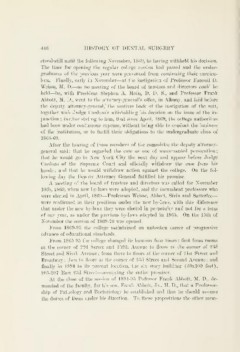Page 488 - My FlipBook
P. 488
;•
446 HISTOKY OF DENTAL SURGERY
stand-still until the following November, 1869, he having withheld his decision.
The time for opening the regular college session had passed and the under-
graduates of the previous year were jirevented from continuing their curricu-
lum. Finally, early in November—at the instigation of Professor Faneuil D.
Weisse, M. D.—as no meeting of the board of trustees and directors could be
held—he, with President Stephen A. Main, D. D. S., and Professor Frank
Abbott, M. D., went to the attorney-general's office, in Albany, and laid before
the deputy attorney-general," the motives back of tlie instigation of the suit,
together with Judge Cardozo's withholding his decision on the issue of the in-
junction; further stating to him, that since April, 1869, the college authorities
had been under continuous expense, without being able to conduct tlie business
of the institution, or to fulfill their obligations to the undergraduate class of
1868-69.
After the hearing of these members of the committee the deputy attorney-
general said : that he regarded the case as one of unwarranted persecution
that he would go to New York City the next day and appear before Judge
Cardozo of the Supreme Court and officially withdraw the case from his
hands; and that he would withdraw action against the college. On the fol-
lowing day the Deputy Attorney General fulfilled his promise.
A meeting of the board of trustees and directors was called for November
10th, 1869, when new by-laws were adopted, and the incumbent professors who
were elected in April, 1869—Professors Weisse, Abbott, Stein and Satterlee—
were reaffirmed in their positions under the new by-laws, with this difference
that under the new by-laws they were elected in perpetuity and not for a term
of one year, as under the previous by-laws adopted in 1865. On the 15th of
November the session of 1869-70 was opened.
From 1869-95 the college maintained an unbroken career of progressive
advance of educational standards.
From 1865-95 the college changed its location four times; first from rooms
at the corner of 22d Street and Fifth Avenue to floors at the corner of 2.3d
Street and Sixth Avenue; from there to floors at the corner of 21st Street and
Broadway; then to floors at the corner of 23d Street and Second Avenue: and
finally in 1891 to its present location, the six story building (50x100 feet),
205-207 East 23d Street—occupying the entire premises.
At the close of the session of 1894-95 Pofessor Frank Abbott, M. D., de-
manded of the faculty, for his son, Frank Abbott, Jr., M. D., that a Professor-
ship of Pathology and Bacteriology be established and that he should assume
the duties of Dean under liis direction. To these propositions tlie other mem-
446 HISTOKY OF DENTAL SURGERY
stand-still until the following November, 1869, he having withheld his decision.
The time for opening the regular college session had passed and the under-
graduates of the previous year were jirevented from continuing their curricu-
lum. Finally, early in November—at the instigation of Professor Faneuil D.
Weisse, M. D.—as no meeting of the board of trustees and directors could be
held—he, with President Stephen A. Main, D. D. S., and Professor Frank
Abbott, M. D., went to the attorney-general's office, in Albany, and laid before
the deputy attorney-general," the motives back of tlie instigation of the suit,
together with Judge Cardozo's withholding his decision on the issue of the in-
junction; further stating to him, that since April, 1869, the college authorities
had been under continuous expense, without being able to conduct tlie business
of the institution, or to fulfill their obligations to the undergraduate class of
1868-69.
After the hearing of these members of the committee the deputy attorney-
general said : that he regarded the case as one of unwarranted persecution
that he would go to New York City the next day and appear before Judge
Cardozo of the Supreme Court and officially withdraw the case from his
hands; and that he would withdraw action against the college. On the fol-
lowing day the Deputy Attorney General fulfilled his promise.
A meeting of the board of trustees and directors was called for November
10th, 1869, when new by-laws were adopted, and the incumbent professors who
were elected in April, 1869—Professors Weisse, Abbott, Stein and Satterlee—
were reaffirmed in their positions under the new by-laws, with this difference
that under the new by-laws they were elected in perpetuity and not for a term
of one year, as under the previous by-laws adopted in 1865. On the 15th of
November the session of 1869-70 was opened.
From 1869-95 the college maintained an unbroken career of progressive
advance of educational standards.
From 1865-95 the college changed its location four times; first from rooms
at the corner of 22d Street and Fifth Avenue to floors at the corner of 2.3d
Street and Sixth Avenue; from there to floors at the corner of 21st Street and
Broadway; then to floors at the corner of 23d Street and Second Avenue: and
finally in 1891 to its present location, the six story building (50x100 feet),
205-207 East 23d Street—occupying the entire premises.
At the close of the session of 1894-95 Pofessor Frank Abbott, M. D., de-
manded of the faculty, for his son, Frank Abbott, Jr., M. D., that a Professor-
ship of Pathology and Bacteriology be established and that he should assume
the duties of Dean under liis direction. To these propositions tlie other mem-


